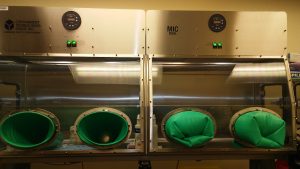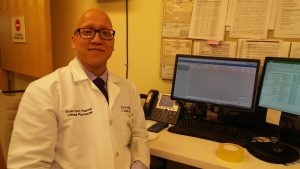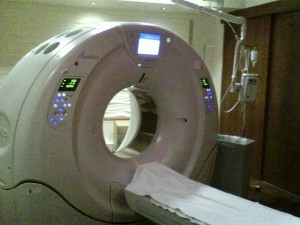Continue reading Radon Gas, The Invisible Cause of Lung Cancer
Continue reading Radon Gas, The Invisible Cause of Lung Cancer

Before I concluded my chemotherapy, I sat down with the pharmacist who had mixed my drugs for nearly three years and recorded our conversation for my erstwhile podcast, The Deep Breath. It offered a revealing look inside the process of administering chemo, as well as other drugs used to treat cancer patients.

I did not realize that I was one of the longest consistent patients currently receiving treatment at this facility. Although I was preparing to call chemo quits after slightly more than 2.5 years, I knew of at least one patient who had been on the same basic regimen as me for around seven years. But that had been before my time. As I settled in to interview my pharmacist, he revealed that he was not aware of any patient at the clinic who had been receiving chemotherapy as long as I had been since he started the job. I appreciated the special distinction, even though I had mixed feelings about it. Continue reading Inside a Chemo Clinic Phamacy
I knew that I would not stay on chemotherapy forever. So getting to the point where I ended my “chemo journey” was not completely surprising. In fact, I had anticipated that a change would be good for some time — after over 2 1/2 years of the same routine, not only had it begun to gnaw at me each time I faced another infusion and ensuing side effects, but there was something of a “gut feeling” that the chemotherapy drug I had been on for so long had done about all it could do. I was probably influenced a lot by the promise of Immunotherapy drugs that had become the media darlings of the cancer world. When my oncologist said it was a good time to consider another approach, I was eager to do it.
Besides immunotherapy, for which I had hoped to join a clinical trial, there was the possibility that I might harbor an actionable gene mutation for my adenocarcinoma. My initial genetic analysis from a biopsy prior to starting chemo had shown none of the mutations that were being directly treated at that time. But a couple of years makes a big difference in the cancer world, especially with the increasing rate of progress science has been making over the past few decades. A re-analysis of that old biopsy showed nothing new, but a quick, painless liquid biopsy — two simple tubes of blood and fifteen minutes of my time — revealed that I harbor a fairly rare mutation, one that affects roughly two percent of the adenocarcinoma subset of lung cancer patients: ErbB2, also known as HER2.
This shifted gears for me regarding the drive down my treatment path. It also made me shift perspective. There is the question, now, of whether finding myself in such a cancer minority is a sign of good fortune. On one hand, it means that my genetic demographic is not highly studied — the downside to minority group patients is simply that there are fewer of us to put into clinical trials. Flip that over, however, and it makes the trials that have been done highly specific — and it makes the case studies on patients with this mutation also highly specific. Which in turn suggests that this might be a very positive development after all. Continue reading Frying Pan, Meet Fire – Leaping from One Therapy to Another
As long-time readers know, I take issue with a number of high-profile “wellness warriors” and anti-science advocates who claim to offer “natural,” “holistic,” or simply “alternative” treatments that can cure cancer or prevent it entirely. Chief among these are Chris Wark and Ty Bollinger, two people with absolutely no scientific or medical training and tons of bad advice. They are part of a large network of disreputable and largely discredited hucksters, many of whom get by on their claims by offering just the tiniest shred of truth mixed in with their hyperbole and insidious messages. They thrive in our increasingly anti-intellectual culture, where headlines and sound bytes sway their customers and their “fan base” into believing that there is substance to their messages. This is why, more than ever, it is essential to take a critical approach to all the medical headlines that are presented, and especially those making extraordinary claims.
The well-established and professionally vetted website, Healthline, has a very good primer on the subject of spotting fake medical news. It could hardly be more topical. There is nary a day that goes by when some website or other isn’t making absurd claims about the latest health craze or danger. Whether it is bloating the risks of GMO foods or misrepresenting the cancer risk from eating red or processed meat, there are more sources out there in the ether intent upon cherry picking data or simply removing it from context in order to sell their point than there are serious outlets for the reporting of science news. Part of the problem with this is that science news isn’t usually considered very sexy or commercial, but a bigger problem is that it is generally difficult for most people to fully understand.
And capitalizing on that, we have opportunists like Chris Wark, a self-proclaimed guru on defeating cancer without chemotherapy. Duly note, of course, that Mr. Wark was cured through surgical intervention and, while chemotherapy was recommended as an adjunctive treatment to lower the risk of future metastasis, there was no indication that he had any actual, existing metastases that needed treatment. To put it bluntly, he was one of the lucky colon cancer patients who had it all taken out without any recurrence. This had nothing to do with whether or not he received chemotherapy, and there is no way of knowing how he would have responded to such treatment or whether his “lifestyle” choices have had any bearing whatsoever on his post-surgical health. Continue reading Common Sense, Clarity and Wellness Warrior Lies
My recent post on dealing with change and adversity was inspired in no small part by a change I am facing in my own life, one rife with uncertainty and heavy with anticipation. The last CT scan I had showed that my primary tumor, the one by which we gauge progression or lack thereof, was still within the technical boundaries of business as usual. That is to say, its lateral dimensions had not changed significantly since the previous scan, and overall had not grown enough over the similar measurements from a year or two years ago to precipitate anxiety. But CT scans are, for lack of a better term, a bit fuzzy. The images are fairly clear, but the data is difficult to measure with absolute precision.

Because CT scans are essentially three-dimensional, but are viewed on two-dimensional screens, comparisons between scans are inherently imprecise. The angle of a subject’s body, how inflated the lungs were, the position of the subject within the imagining chamber, all figure into subtle differences between the final scans. On top of that, because the images are basically multitudes of cross-sectional snapshots, a comparison must be made by selecting the closest approximation to the “same” image between scans from different times. I’ve looked at lots of these — in fact, I keep digital copies of all my scans for reference or posterity — and I’ve used the tools to line up and measure my tumor as best I can.
And in two dimensions, at the standard viewing cross-sectional approximation, my mass looks very similar from scan to scan, every three or so months since this process began. My chemotherapy was clearly doing what it was intended to do, which was to prevent progression of the disease. Progression is generally defined in terms of the length of the tumor, but we all know that tumors are bundles of cells that grow and change along more than just one axis.
I was never under any illusion that the chemo would cure me — there is no official cure for Stage 4 Lung Cancer. Any time that the chemotherapy could afford me by maintaining stasis has been considered a luxury and at over two and a half years on this particular regimen, I have been the longest continuous success case that many on my medical team have known. So the next time I see most of them will be a special, bitter-sweet occasion.
Because the time for change has come. Continue reading Chemo and I Had a Pretty Good Run
Here’s a thought that needs to be considered. Since the United States is not doing its part to fight global climate change, nature will not be able to keep up. This REQUIRES us to be open-minded about the advantages science offers to help our species adapt. Science-denial is one of the biggest reasons we are in this mess, but science can help mitigate the damage if it is embraced and supported in a reasonable, methodical and pro-active manner. One of the areas that must be re-evaluated by many is the use of GMO crops.

There is overwhelming evidence from unbiased sources that show the safety of these crops, many of which are modified explicitly to be able to grow under hotter and drier conditions, or in soil that would not otherwise support proper plant development. Already, without the use of GMO crops, it would be difficult to keep up with the food production needs of the planet. Within the next decade, there is little doubt left that human food will be largely reliant upon GMO crops for minimum sustainability. I propose that it is time to look at the science objectively and stop reacting to fear-based marketing that mostly just serves alternative health websites and their advertisers or overpriced processed food manufacturers.

In the spirit of an interview I will be conducting tomorrow on Critical Thinking, I invite you to check your confirmation bias before reading the link below. Now, more than ever, this is becoming an essential skill, especially in the age of social media and 10,000 clicks per second “information” sharing.
Also essential is the ability to differentiate legitimate viewpoints from pure nonsense. (“Nonsense” would be any argument for the existence of chemtrails, for example.) A “legitimate” viewpoint always requires two things: clear logic and reliable sources. This is an incredibly low bar, but people, it seems, are often inclined to stoop much lower.
As a disclaimer, I buy a lot of organic food. But not because I think it is safer or healthier. I am much more inclined to buy LOCAL, which has a greater positive impact than organic and often tastes better, too, though I am fortunate enough to live in an area where much of the local is organic, if that is what I am looking for. But I have also talked with people who source organic for their products about why sometimes they specifically choose non-organic, not the least reason being that it is often ethically superior and more environmentally friendly NOT to be organic. Organizations like the EWG (Environmental Working Group) tend to only tell a distorted part of the story, and they certainly present data from a heavily skewed perspective (we expect this from corporate mouthpieces for Big Agriculture, and the EWG is no different — it is just a corporate propaganda arm for the organic foods industry).
But, like I said, if you can, let go of your confirmation bias. Assume that what you “feel” isn’t necessarily true. Assume that you are wrong, or at least only partially right, and that maybe you will find something to fill in the blanks and help you arrive at a reasonable conclusion. It’s good practice. We all need it. Only an exercised skill stays sharp and critical thinking is no different.
Read this article by Steven Savage and feel free to come back here and comment.
Then go get something fresh to eat.
I’ve mentioned the blog, Every Breath I Take, before, and spoken highly of its author, Lisa Goldman. Like myself, she was in her 40s when she was diagnosed with Stage IV Lung Cancer — although she was in her very early 40s, compared to my “mid-ish” — and, also like myself, she was a non-smoker. Her most recent post is an impassioned response to a special issue of Cure magazine, dedicated to lung cancer, that resonated as a major fail from the publication.
Read Lisa’s response here: http://lisa.ericgoldman.org/lung-cancer-facts/call-to-action-stop-promoting-lung-cancer-stigma-in-the-media
She also set up a petition to encourage the media to stop promoting the lung cancer stigma.
It is in the best interest of all patients to re-write the cancer narrative away from being a smoker’s disease, and away from being an automatic death sentence. While rates of the disease continue to climb and it remains the world’s most deadly cancer, clearly it is not the cancer that we have been sold on for so many years. Smoking is a stupid habit and greatly increases risk, and it was a useful tool to make lung cancer the whipping post for awareness. But the resulting stigma facing lung cancer patients is unwarranted.
Put that in your pipe and smoke it.

Yesterday was Easter. Today I am in the chair at the infusion center, watching a steady drip work its way into my arm. At some point over the next few days I will likely be scheduling an “exit interview” with a friend who is going to die from his cancer within the coming weeks. There is an interesting, perhaps timely mix of metaphor in all this. The holiday, for those who celebrate its religious significance, is about spiritual rebirth (and literal rebirth for the more fundamentalist among us). I look at these chemicals entering my bloodstream right now as agents of my own rebirth, my second chance at life for as long as it may last, a chance to try and get some things right while I am here. And my friend’s impending death is a reminder that, even with the best of science and consistent faith, these days do come to an end for us all, whether we are ready or not.
Michael March as been, as far as I can tell, a solid Christian and a man of reason. He chose to evaluate all available treatment options, pursuing even the difficult ones when they offered a clear explanation of potential outcomes backed by decades of studies and documented successes. For eight years, he has dealt with various cancers, outliving each prognosis because of committing to his treatments. But at each stage, from diagnosis to remission to reoccurrence, he has been forced to examine his own mortality and come to peace with the idea that he may not see another birthday or Christmas or, as is now the case, another Easter. This was his final celebration of his faith’s Resurrection Story. For Michael, there is a definite end to this existence as we know it, and he is facing it with the determination of ensuring a positive legacy. Continue reading Death, Rebirth, Living On
Through the wonder that is Social Media, I’ve connected to a wide range of people with their own personal cancer stories. As an extension to this blog, and as part of the research for both a broader understanding of the treatment options out there in the big, wide world, and the book I have been slowly developing to help guide future patients and caregivers through this often difficult and confusing process, I have been collecting interviews from a growing pool of diverse perspectives. Most of these interviews end up in my Patreon feed, where my podcast/video blog has its official home.
One of my recent acquaintances was the wonderful Lizz, who writes a lively blog called The Drop Off, which recently acquired the subtitle of “TRAVERSING THE INCURABLE, HELP AND HUMOUR FROM A CANCER SUFFERS WIFE.”
This subtle change under the title of her blog was a point addressed in our lengthy conversation via Skype. Continue reading The Cancer Sufferer’s Wife